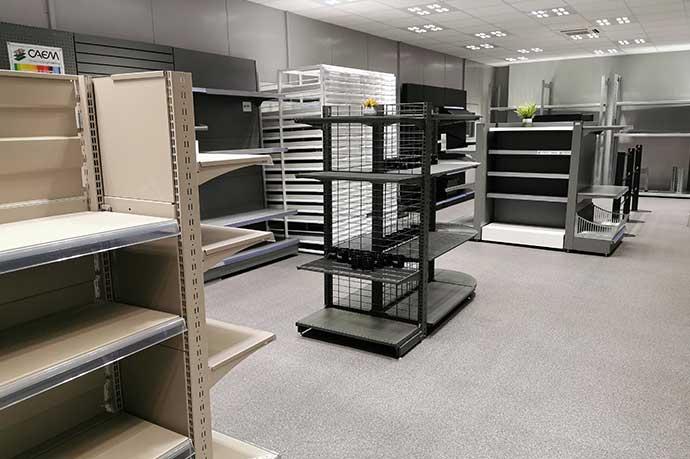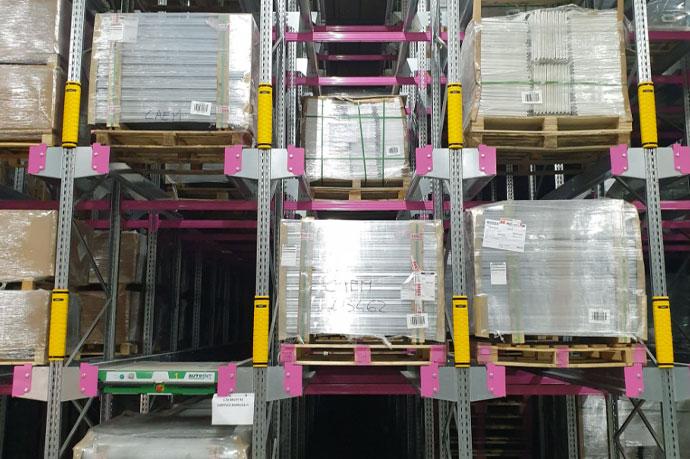https://www.caem.co.uk/ls9-longspan-shelving
Battery Storage Racks - Maximize Efficiency & Space in Retail Environments
Imagine a bustling retail environment where the lights never flicker, and the cash registers always operate, even during a power outage. This scenario isn't just a dream but a reality made possible by battery storage racks. As energy costs continue to rise and sustainability becomes increasingly important, these storage solutions offer retailers an ingenious approach to energy management, allowing businesses to store and utilize electricity efficiently while maximizing valuable floor space.
Introduction to Battery Storage Racks
Battery storage racks are organized frameworks designed specifically for storing energy storage systems, optimizing space while ensuring easy access for maintenance. In commercial settings like retail environments, these systems provide reliable energy backup that leads to significant operational benefits.
A battery rack functions as a modular system holding multiple battery modules, similar to how servers are stored in data centers. This design not only maximizes limited floor space but enables scalability to match evolving energy needs. According to industry reports, retailers deploying battery storage can achieve direct electricity cost reductions of 10–30%, depending on utility rate structures and storage capacity.
The strategic advantage these systems offer is substantial. Retailers can store energy during off-peak times when electricity is cheaper and use it during peak demand periods, significantly reducing utility costs. Furthermore, battery storage provides essential backup during outages, ensuring critical operations like point-of-sale systems, lighting, and refrigeration continue uninterrupted. Recent data shows that properly sized storage systems can achieve 70–90% reduction in outage-related downtime and business interruption losses.
Battery storage racks also support integration of renewable energy sources like solar panels, helping retailers maximize green energy investments. With the declining cost of lithium-ion batteries—now at a record low of $115/kWh—these systems have become increasingly cost-effective for retail adopters, with ROI timeframes shortening to just 3-5 years when combined with available tax incentives.
Types of Battery Storage Racks and Their Applications
Battery storage racks come in various configurations to accommodate different retail needs and space constraints. Each type offers distinct advantages depending on your specific requirements.
Standard Racks provide simple yet effective solutions for organizing batteries in retail settings. Available in configurations from single to four-step designs, these racks allow easy access and organization by size or brand, making them ideal for stores where customers need straightforward access to various battery types.
Fixed Racks feature robust construction for stability and security, suitable for dedicated battery sections within retail spaces that don't require frequent rearrangement. For example, Konterra Headquarters in Maryland implemented fixed racks as part of their 500 kW AC lithium-ion battery storage system, providing them with reliable backup power during outages while reducing operational energy costs.
Mobile Racks equipped with wheels offer flexibility in retail spaces where seasonal promotions or changing layouts are common. Their lightweight design facilitates easy movement, making them ideal for dynamic retail environments that frequently reposition displays.
Slanted Shelf Racks incorporate angled shelves promoting first-in, first-out (FIFO) rotation—vital for managing inventory with limited shelf life. This design ensures older stock sells first, minimizing waste and improving inventory management efficiency.
Modular Racks provide customizable storage solutions tailored to specific retail needs. These can be expanded or reduced according to inventory requirements, allowing retailers to adapt their displays as product lines evolve. One automotive retailer implemented specialized gravity flow steel battery storage racks that accommodated up to 96 automotive batteries per unit, improving product visibility while enhancing safety and reducing handling risks.
Multi-Tiered Options maximize vertical space, making them invaluable in smaller retail locations with limited floor area. These racks can display multiple battery types within a compact footprint, enhancing product visibility and accessibility while optimizing space utilization.
In commercial settings requiring large-scale energy storage, Commercial Battery Racks provide robust solutions designed for high-volume applications. These systems can be configured to meet specific power requirements and space constraints, offering retailers scalable options as their energy needs grow.
Key Features and Benefits of Battery Storage Racks
Modern battery storage racks deliver numerous advantages beyond simple storage, making them valuable investments for forward-thinking retailers.
Optimized Space Utilization ranks among the most significant benefits for space-constrained retail environments. Well-designed battery racks maximize both floor and vertical space, allowing stores to implement energy storage solutions without sacrificing valuable retail area. Installing battery storage can lower peak demand charges by 15–40%, according to recent market analyses—a crucial advantage for retailers where every square foot must generate revenue.
Enhanced Safety and Protection are paramount in battery storage solutions. Quality racks provide stable housing for batteries, safeguarding against physical impacts and potential chemical exposure. In the UK, systems must comply with standards like BS EN IEC 62485-5, which specifies safety requirements including ventilation, enclosure integrity, and protection against short circuits. For lithium-ion battery storage specifically, enclosures must meet at least IP2X for general protection and IP4X for top surfaces.
Improved Accessibility and Maintenance are facilitated by well-organized rack systems. Easy access to individual batteries simplifies maintenance tasks, reduces operational downtime, and ensures smooth retail operations. This was demonstrated in the Logos 3PL case study, where a dedicated storage area featuring specialized battery racks for BESS modules included web-based temperature and humidity monitoring for instant environmental data access, ensuring optimal storage conditions.
Backup Power and Resiliency represent critical benefits for retailers. Battery storage systems provide reliable backup during grid outages, minimizing sales losses and protecting electronic equipment. This resilience is increasingly valuable as grid reliability concerns rise due to higher demand from data centers and extreme weather events.
Cost Savings Through Peak Shaving allows retailers to store energy during off-peak hours and use it during peak demand periods. This strategy can significantly reduce energy costs, with recent data showing that retailers with storage can manage and reduce demand charges by 15–40%. The availability of federal investment tax credits has further improved financial returns, shortening typical ROI timeframes to 3–5 years for behind-the-meter battery storage systems.
Regulatory Compliance is ensured with modern racks designed to meet industry safety standards like BS 7671 (IET Wiring Regulations) and PAS 63100:2024 for fire safety. This compliance reduces the risk of penalties and ensures safe operation within the UK's regulatory framework.
Scalable Design Options future-proof your investment by accommodating additional storage capacity without extensive modifications. This flexibility ensures businesses can expand their energy storage capabilities as needs evolve, maintaining adaptability to changing energy demands. Many retailers start with modest systems that can be expanded incrementally, reducing initial capital expenditure while preserving future options.
Battery Rack Comparison: Features and Specifications
|
Rack Type |
Weight Capacity |
Typical Dimensions |
Material |
Best For |
Price Range |
|
|
Standard Racks |
Low-Medium (50-200kg) |
W:60-120cm, D:30-60cm, H:150-200cm |
Steel, Aluminum |
Basic battery display, small retailers |
£300-£800 |
|
|
Fixed Racks |
High (200-500kg+) |
W:80-150cm, D:40-80cm, H:180-250cm |
Heavy-duty steel |
Permanent installations, dedicated sections |
£600-£1,500 |
|
|
Mobile Racks |
Low-Medium (50-150kg) |
W:60-100cm, D:40-60cm, H:120-180cm |
Lightweight steel, aluminum |
Flexible retail spaces, temporary displays |
£400-£1,000 |
|
|
Slanted Shelf |
Medium (100-300kg) |
W:80-120cm, D:40-60cm, H:150-200cm |
Steel, reinforced shelving |
FIFO inventory management |
£500-£1,200 |
|
|
Modular Racks |
Variable (100-400kg) |
Customizable |
Steel, composite materials |
Expanding businesses, adaptive layouts |
£700-£2,000 |
|
|
Commercial Energy Storage |
Very High (500kg-1000kg+) |
Custom to site |
Industrial steel, specialized materials |
Large-scale energy storage systems |
£2,000-£10,000+ |
Choosing the Right Battery Storage Rack for Your Needs
Selecting the appropriate battery rack requires careful consideration of several key factors to ensure optimal performance, safety, and return on investment.
Safety and Compliance must be your first priority. Choose battery racks that adhere to UK standards such as BS EN IEC 62619:2022 for lithium batteries and PAS 63100:2024 for fire safety guidance. These standards ensure your storage solution provides adequate protection in retail environments where both staff and customer safety are paramount.
Structural Integrity and Weight Capacity are critical considerations. Your chosen battery rack must handle the weight and dimensions of the batteries it will store, with appropriate safety margins. Secure anchoring systems prevent tipping or collapse, particularly important in high-traffic retail settings. Consider racks with proven load-bearing capacity similar to industrial shelving systems.
Space Utilization and Accessibility directly impact operational efficiency. Select racks that maximize available space while allowing easy access for maintenance and inspections. Proper spacing between batteries facilitates ventilation, preventing overheating and maintaining battery health—a requirement under BS EN IEC 62485-5 safety standards.
Scalability and Adaptability future-proof your investment. Modular rack systems that can be expanded as storage needs grow offer long-term cost efficiency. The Quick-Pik Automotive Battery Rack case study demonstrated how specialized gravity flow racks could be configured to store varying quantities of batteries, achieving higher profit per square foot through increased storage density.
Material Quality and Durability affect both safety and total cost of ownership. Invest in racks constructed from high-quality, non-conductive, and corrosion-resistant materials to ensure longevity and resistance to environmental factors. For large retail operations, this consideration is particularly relevant where durability and safety are crucial.
Energy Management Integration capabilities should align with your broader energy strategy. Modern battery racks increasingly incorporate smart monitoring systems that track performance metrics and allow for remote management. These features enhance operational efficiency and can identify potential issues before they become problems, reducing maintenance costs and downtime.
When evaluating options, consider bringing in specialists familiar with battery storage installations in retail environments. Their expertise can help identify the most appropriate solution for your specific needs while ensuring compliance with all relevant regulations and maximizing your return on investment.
Future Trends and Innovations in Battery Storage Racks
The battery storage landscape continues to evolve rapidly, with several emerging trends poised to reshape how retailers approach energy management and storage.
Advanced Battery Chemistries are moving beyond traditional lithium-ion technology. Newer options like solid-state and enhanced redox flow batteries offer higher energy densities, improved safety profiles, and extended lifespans. For retailers, these advancements mean more reliable performance with reduced maintenance requirements and lower lifecycle costs. The International Energy Agency projects that as these technologies mature, average electricity costs for mini-grid systems could be halved by 2030.
Smart Grid Integration is transforming battery storage from passive backup to active grid participants. Modern rack systems increasingly include monitoring and management capabilities that enable real-time adjustments based on energy prices and demand. This intelligence allows retailers to participate in demand response programs, generating additional revenue while supporting grid stability. Battery systems with these capabilities can provide services such as frequency regulation and fast-power balancing, as demonstrated in the Konterra Headquarters case study.
Modular and Flexible Designs are becoming standard as retailers seek adaptable solutions. Next-generation racks feature plug-and-play modularity, allowing for easy expansion or reconfiguration as energy needs change. This flexibility reduces the risk of overinvestment while ensuring systems can grow alongside business requirements.
Enhanced Safety Features address concerns about battery thermal events. Innovations include advanced fire detection, suppression systems, and thermal runaway prevention. In the UK, compliance with PAS 63100:2024 requires mounting batteries on certified, fire-resistant surfaces with adequate ventilation—requirements that newer rack systems increasingly integrate by design.
Space-Efficient Configurations continue to improve, with vertical integration allowing retailers to maximize energy storage capacity within limited footprints. These space-saving innovations enable even small retail locations to benefit from on-site energy storage without sacrificing valuable floor space.
Battery Storage as a Service (BaaS) models are emerging as alternatives to outright ownership. These subscription-based approaches reduce upfront capital expenses while providing access to the latest technology and expert management. For retailers hesitant to make large investments in rapidly evolving technology, these models offer an attractive entry point with predictable operating expenses.
As retailers face increasing pressure to reduce carbon footprints while managing rising energy costs, battery storage racks will play an increasingly central role in retail energy strategies. By staying informed about these trends, forward-thinking retailers can position themselves to benefit from the continued evolution of storage technology while gaining competitive advantages through improved energy resilience and cost management.
Frequently Asked Questions About Battery Storage Racks
What is the typical ROI timeframe for battery storage systems in retail? With recent cost reductions and available incentives, retailers are now seeing payback periods as short as 3–5 years for behind-the-meter battery storage systems, compared to previous averages of 7–10 years. This calculation typically accounts for energy cost savings, demand charge reductions, and potential revenue from grid services.
What safety standards must battery storage racks meet in UK retail environments? UK battery installations must comply with several key standards including BS EN IEC 62485-5, PAS 63100:2024 for fire safety, and BS 7671 for electrical installations. These regulations cover ventilation requirements, enclosure integrity, fire-resistant mounting, and appropriate circuit protection.
How much space is typically required for a retail battery storage installation? Space requirements vary based on capacity needs, but modern systems are increasingly compact. A 50kWh system typically requires approximately 2-3 square meters of floor space, while larger systems may require dedicated rooms or external housing. Vertical rack configurations can significantly reduce the footprint.
Can battery storage systems integrate with existing retail energy management systems? Yes, modern battery systems feature compatibility with building management systems (BMS) and energy management software. This integration allows for coordinated operation with HVAC, lighting, and other energy-consuming systems to maximize efficiency and cost savings.
What maintenance is required for battery storage racks in retail environments? Maintenance requirements depend on battery chemistry and system complexity. Lithium-ion systems typically require minimal maintenance beyond regular visual inspections, thermal monitoring, and periodic system diagnostics. Older lead-acid systems require more frequent attention. Most modern systems include remote monitoring capabilities that alert operators to potential issues before they become problems.
Are there grants or incentives available for retail battery storage installations in the UK? Yes, various incentives exist including enhanced capital allowances, potential eligibility for renewable energy incentives when paired with solar, and regional development grants. Additionally, businesses can benefit from grid services revenue streams by allowing their battery systems to participate in demand response programs.
How do battery storage racks contribute to sustainability goals? Battery storage supports sustainability by enabling greater renewable energy integration, reducing grid dependency during peak demand (when generation is often from carbon-intensive sources), and potentially providing emergency power that reduces the need for diesel generators. The environmental benefits increase when the system is charged primarily from renewable sources.
https://www.caem.co.uk/ls9-longspan-shelving





